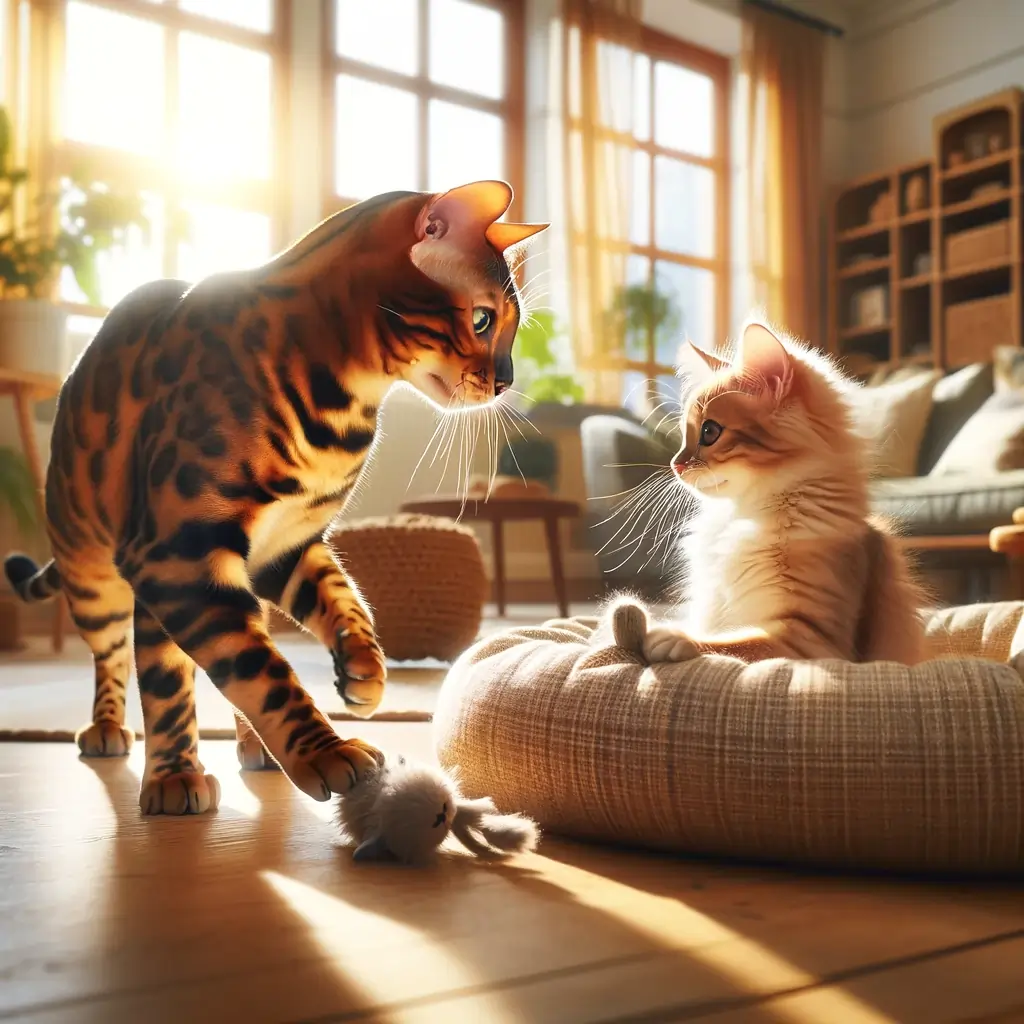When considering bringing a Bengal cat into a multi-cat household or pondering if your existing Bengal cat needs a companion, many questions may arise. Bengal cats, known for their unique leopard-like appearance and dynamic personalities, often stir curiosity about their compatibility with other cats.
This article delves into the essentials of Bengal cats’ social behavior, their interactions with other felines, and practical tips for owners to ensure a harmonious household.
How do Bengal Cats’ Personalities Affect Their Relationships with Other Cats?
Understanding the Playful and Affectionate Nature of Bengals
The playful and affectionate nature of Bengal cats can significantly influence their relationships with other cats. Bengals are energetic and require ample playtime; thus, they might see another cat as a potential playmate. This tendency towards playfulness can be a double-edged sword, as not every cat appreciates the high energy levels or playful advances of a Bengal.
However, when Bengal cats get along with other feline companions, they exhibit profound affection, often engaging in mutual grooming and cuddling sessions.
Assessing the Territorial Behavior of Bengal Cats
Bengal cats are known to have a territorial nature, which might lead to clashes when introducing another cat into their domain. This territorial streak can manifest as aggression or marking behaviors, especially if the Bengal feels threatened by the new arrival.
The Bengal cat owner must manage these behaviors thoughtfully to prevent any issues. Sometimes, neutering can help reduce territorial tendencies and make cohabitation more peaceful.
Comparing Bengal Cats’ Energy Levels with Other Breeds
One of the standout features of Bengal cats is their high energy level, significantly different from many other cat breeds. When Bengals live with other cats of similarly active breeds, such as Abyssinians or Siamese, they tend to get along well because they share a similar play drive.
However, more sedentary breeds might find the relentless energy of Bengal cats overwhelming. Understanding and matching the energy levels and personalities of the cats involved can play a pivotal role in ensuring a harmonious household.
Introducing Another Cat to a Bengal Cat: Steps for a Smooth Transition
Preparation Before Bringing Another Cat Home
When you decide to introduce another cat to a Bengal cat, preparation is key. Creating a neutral space where neither cat feels ownership can help minimize territorial responses. Owners should also ensure there are ample resources to go around—extra litter boxes, food bowls, and sleeping areas can help prevent resource guarding and promote peace.
The Ideal Way to Introduce a New Cat to a Bengal
The introduction process should be gradual. Initially, keep the cats in separate rooms, allowing them to sniff each other under the door to become accustomed to one another’s scent without direct contact.
Over days or weeks, gradually increase their exposure to each other in controlled, supervised environments. Utilizing toys and treats can help foster positive associations between the Bengal cat and the new cat.
Signs of a Successful Introduction Between Bengal Cats and NewComers
Signs of a successful introduction include non-aggressive body language, such as relaxed postures, the absence of hissing, and mutual curiosity without fear. Over time, you might observe the cats playing together, grooming each other, or even resting together, clear indicators that Bengal cats can indeed get along with other cats.

Can Bengal Cats Live Peacefully with Other Cat Breeds?
Compatibility with Specific Breeds like Siamese and Abyssinian
Bengal cats often find great companionship with certain breeds that match their personality and energy levels. Siamese and Abyssinian cats, known for their social behavior and high activity, can make excellent companions for Bengals, potentially leading to a vibrant and interactive household. These breeds share the playful, explorative nature of Bengals, making them more likely to coexist peacefully.
Factors That Influence Inter-breed Harmony
Several factors can influence whether Bengal cats get along with other breeds, such as early socialization, the cats’ ages, and the personalities involved. Bengals introduced to a variety of cats at a young age may grow more adaptable and tolerant. Similarly, compatible personalities, regardless of breed, can lead to successful feline friendships.
Therefore, every cat is different, and predicting inter-breed harmony involves considering these unique variables.
Testimonials from Owners who Have Both Bengals and Other Breeds
Many owners of Bengal cats who have successfully introduced them to other breeds often share their stories, providing valuable insights into what can work. These testimonials highlight the importance of understanding the individual personalities of each cat involved and reaffirm that with patience, proper introduction techniques, and understanding, Bengal cats can indeed live harmoniously with other breeds.
Dealing with Aggression: When Bengal Cats Don’t Get Along with Others
Identifying the Signs of Aggression in Bengal Cats Towards Other Felines
Bengal cat owners must recognize the signs of aggression early to prevent potential conflicts. These signs can include hissing, growling, arching the back, and even physical altercations. Often, these behaviors stem from fear or territorial disputes and require intervention to de-escalate the situation.
Strategies to Reduce Territorial Aggression in Bengals
To mitigate territorial aggression, ensure that each cat has its own space and resources. Introducing scent-swapping exercises, where toys or blankets are exchanged between the cats, can also help by familiarizing each cat with the other’s scent. Additionally, maintaining a routine can provide a sense of security and predictability for the Bengal, helping to reduce stress and aggression.
When to Seek Professional Help for Inter-cat Aggression
If aggressive behaviors persist despite your best efforts, seeking professional help from a veterinarian or a feline behavior specialist may be necessary. They can offer tailored advice, potential medical interventions, and behavioral modification techniques to help your cats coexist more peacefully.

Essential Tips for Bengal Cat Owners to Foster a Harmonious Multi-Cat Household
The Importance of Neutering to Reduce Territorial Tendencies
Neutering Bengal cats can significantly reduce territorial and aggressive behaviors, making them more apt to coexist peacefully with other cats. This procedure can decrease the likelihood of marking territories and can lead to a calmer, more sociable cat.
Setting Up a Cat-friendly Environment With Adequate Resources
To foster a peaceful cohabitation, ensure your home is equipped with ample resources for all cats involved. Multiple litter boxes, feeding stations, and quiet resting areas can help prevent competition and stress. Additionally, cat trees and enrichment toys can provide necessary stimulation, particularly for high-energy breeds like Bengals.
Regular Socialization and Playtime to Encourage Positive Interactions
Regularly scheduled playtime and socialization activities can help encourage positive interactions between Bengal cats and other household felines. Engaging toys, puzzle feeders, and even clicker training sessions can keep Bengals mentally and physically stimulated, reducing the chance of boredom-related behavioral issues.
Conclusion
Bengal cats can indeed get along with other cats, provided their personalities are compatible, and their introduction is handled with care. The key to a harmonious multi-cat household lies in understanding the needs and behaviors of your Bengal cat, ensuring they are well-socialized, and creating an environment that supports positive interactions. With patience and the right approach, your Bengal can enjoy the company of feline companions, leading to a more enriching life for all involved.
Q: Do Bengal cats get along with other cats easily?
A: Yes, Bengal cats are naturally social creatures and often enjoy the company of other cats. They have a playful personality which makes them great companions for other feline friends. However, much depends on the individual temperament of the cats involved and whether or not Bengal cats have been properly socialized from a young age.
Q: Do Bengals need another cat for companionship, or can they be the only cat at home?
A: While Bengal cats are indeed social and may enjoy having a companion cat, they can also thrive as the sole cat in the household. An owner of a Bengal cat should ensure they provide plenty of interaction and playtime. If considering adding another cat, introducing a Bengal to a household with an existing cat should be done slowly and carefully to ensure they get along well.
Q: What is the best way to introduce a new kitten to a Bengal cat?
A: Introducing a new kitten to a Bengal cat should be done slowly and with careful supervision. Start by keeping them in separate rooms and gradually allow them to sniff each other under a door. Slowly introduce face-to-face meetings in controlled environments. Providing plenty of toys and separate feeding areas can help ensure a smooth introduction and reduce competition or jealousy.
Q: Would a Bengal cat get along with a dog or other pets in the household?
A: Bengal cats can get along with dogs and other pets if they are introduced carefully and socialized properly. This breed is known for its playful and adventurous nature, which can make them good companions for dogs. Introduce them slowly, supervise their interactions, and ensure each pet has their own safe space.

Hey guys, My name is Simon Smith. I’m from Canada and live near Victoria
I live with my sweet family and have 20+ Ragdolls of different types. I love them as my own children. My profession is as a hotel manager.
I love to keep Ragdolls and grow their breeder case. I have 7 years of experience.
I’m an expert in cat care. So, I’m here to provide you with new information about my cats daily. This is my personal blog website, so I request that you kindly visit our site daily.
If you’re a Ragdolls lover and you have any questions or confusion about cats, text me on the Contact Us page or Gmail.
Thank u
